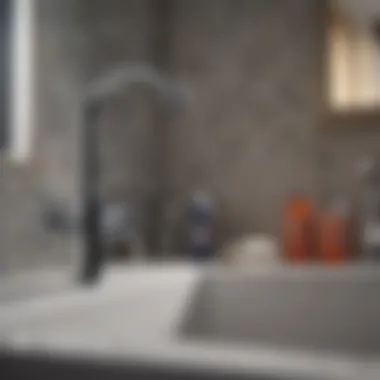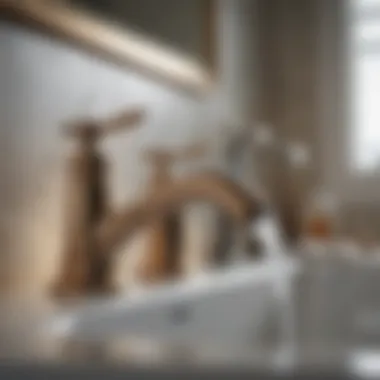Glacier Bay Bathroom Faucet Repair Guide


Intro
When it comes to maintaining your home, small repairs can often feel like a daunting task, especially when it involves plumbing fixtures like your Glacier Bay bathroom faucet. If you've ever faced issues like leaks or irregular water flow, you're not alone. Many homeowners encounter these problems, and the good news is that most repairs can be tackled with the right knowledge and a few essential tools. This guide will help you understand everything from the materials needed, to performing step-by-step repairs, adding confidence to your DIY skill set.
In the sections to follow, we’ll break down every aspect of faucet repair clearly. Whether you're a hands-on homeowner or a novice looking to learn, this guide is catered for you. By the end, you'll not only navigate through repairs like a pro, but also enjoy knowing you've effectively resolved the issues without needing to call in a plumber. Let's kick off by gathering the necessary materials.
Foreword to Glacier Bay Faucets
When it comes to home fixtures, the kitchen or bathroom faucet often gets overlooked, yet it plays a vital role in our daily lives. The Glacier Bay faucet brand marries functionality with stylish design, making it a popular choice among homeowners and landlords alike. In this section, we'll delve into what makes Glacier Bay faucets stand out, providing a backdrop for understanding their maintenance and repair needs.
Overview of Glacier Bay Brand
Glacier Bay, a brand found at Home Depot, delivers a range of faucets that are as practical as they are appealing. The brand has carved out a niche by offering cost-effective solutions without skimping on style. Glacier Bay faucets often feature modern designs that fit seamlessly into various decor styles, whether traditional or ultra-contemporary.
One of the appealing aspects of Glacier Bay is their commitment to innovation. The valves are designed for ease of use, often incorporating technology that benefits both the consumer and the environment. Notably, many of their faucets come equipped with water-saving features, helping households save on their utility bills while also being eco-friendly.
It's worth noting that Glacier Bay faucets generally come with a limited lifetime warranty, which gives consumers peace of mind. When issues arise, knowing the brand stands behind its products makes for a more comfortable repair experience.
Common Features of Glacier Bay Faucets
Glacier Bay faucets are loaded with features that combine aesthetics and functionality. Here are some that you may encounter:
- Single-Handle and Double-Handle Options: Whether you prefer the ease of a single-handle system or the more traditional double-handle setup, Glacier Bay has you covered.
- Spot-Free Finish: Many models boast a finish that resists fingerprints and water spots, keeping your faucet looking pristine with minimal cleaning.
- Easy Installation Design: If you're handy, you'll find that many Glacier Bay faucets are designed for straightforward DIY installation, reducing the need for professional help.
- Diverse Styles: With a range of finishes—from chrome to brushed nickel—you're sure to find a design that complements your space.
- Ceramic Disc Valve Technology: This feature enhances durability and helps reduce faucet leaks, a common issue in plumbing fixtures.
In summary, Glacier Bay faucets offer a mixture of efficiency, aesthetic versatility, and user-friendly designs, making them a strong contender in the market. Understanding these features is crucial as we navigate through repair methodologies and maintenance tips later in this article.
Understanding Faucet Mechanics
When diving into Glacier Bay bathroom faucet repair, grasping the mechanics behind how these fixtures operate is crucial. Understanding faucet mechanics not only sheds light on the typical issues you may face but also empowers you to troubleshoot problems confidently. Any homeowner or housewife engaged in DIY projects will find that comprehending the inner workings of a faucet transforms a daunting task into a manageable one. It’s akin to knowing which part of a clock moves to tell time; once you're clear on that, everything starts to make sense.
Basic Components of a Faucet
Every faucet, Glacier Bay included, shares a set of basic components that play pivotal roles in its functionality:
- Handle: This is what you turn to control the water flow. Depending on the model, it could be a single lever or separate hot and cold handles.
- Spout: This is where the water comes out. Different styles exist, from tall to low arcs, affecting both function and aesthetics.
- Cartridge: Inside the faucet, the cartridge regulates water flow and temperature. Faulty cartridges can often be the source of leaks.
- Aerator: Found at the tip of the spout, it reduces water splash and mixes air with water for a steady flow. Regular cleaning maintains optimal performance.
- Base: This part secures the faucet to the sink. It's essential for stability.
Getting cozy with these parts will save you a fair bit of headache down the road because understanding each function helps in diagnosing issues quickly. For instance, if the faucet is leaking, a worn-out cartridge may be the culprit rather than something more intimidating.
How Water Flow is Controlled
Water flow in a faucet is essentially managed by the interaction of various components, particularly the handle and the cartridge. When you turn the handle, it activates the cartridge, determining how much water flows through based on how far you turn it.
Consider these key points:
- Pressure Regulation: Most homes have standard water pressure, and faucets are made to work optimally under these conditions. If you're troubleshooting, make sure that the main water supply isn't turned down too low.
- Hot and Cold Mix: In dual-handle faucets, each handle controls its own temperature. A misaligned cartridge can lead to unexpected temperature swings.
- Flow Rate Adaptation: Many modern faucets feature flow rate regulators to minimize water waste without sacrificing pressure. This not only benefits the environment but also saves on utility bills.


Understanding how the mechanics of water flow work gives homeowners the ability to make informed decisions about repairs and upgrades. If you notice a discrepancy, like reduced flow or mixed temperatures, likely, something needs attention within these mechanics.
Identifying Common Problems
Recognizing issues with your Glacier Bay bathroom faucet is a crucial first step in any repair process. Identifying common problems early not only saves you time but can also help you avoid deeper damage that might require costly repairs down the line. This section will delve into a few everyday issues that many homeowners encounter, giving you the tools to troubleshoot effectively.
Leaking Faucets
A leaking faucet is often more than just an annoyance; it can inflate your water bill and contribute to water wastage. The symptoms include constant dripping and water pooling around the base. Before you jump to conclusions about needing a replacement, consider checking the washers and O-rings. These components generally wear out over time, leading to leaks.
- Key Causes: Damaged washers, corroded valve seats, or loose fittings.
- Things to Look For: Corrosion spots, damp areas under the sink, or a noticeable increase in your water bill.
Resolving a leak can be a simple task. Oftentimes, it can just take a few minutes to switch out a worn washer. It's keeping an eye on early signs of leaking that can help you steer clear of bigger headaches later on.
Low Water Pressure
Low water pressure is another common issue that can leave you feeling like you're in the desert when you're just trying to wash your hands. You might notice this when the faucet doesn't produce enough water to rinse soap off effectively. Essentially, there can be a few culprits at play here.
- Common Causes: Obstructed aerators, clogged cartridges, or issues with the home’s water supply system.
- Symptoms to Watch: A noticeable drop in water stream and inconsistent flow that could signal something isn't quite right.
To address low water pressure, begin by inspecting the aerator. If it's clogged with mineral deposits or debris, cleaning it can restore pressure significantly. Sometimes, simply turning the faucet on and off may help unstick a valve that’s been sitting too long.
Strange Noises
If your faucet starts making weird noises, it might feel like you’ve got a squirrel stuck in the pipes. Strange sounds—whether that’s rattling, humming, or whistling—can signal different issues. It's essential to address these noises promptly as they can indicate underlying concerns that may lead to further damage.
- Possible Causes: Air in the pipes, loose components, or valves that aren’t functioning correctly.
- Signs to Consider: Hissing while the water is running or sudden banging sounds which can be alarming.
To troubleshoot, check if the noises happen when the water is flowing at certain pressures. It may also help to tighten any visible fittings. If the problem persists, consult a detailed manual or consider whether a more complex issue might require expert intervention.
Identifying these common problems early can save homeowners from costly repairs and the headache of dealing with more severe plumbing issues. Understanding the signals your faucet sends out is key to effective maintenance.
Essential Tools for Repair
When it comes to repairing Glacier Bay bathroom faucets, having the right tools on hand can make all the difference. You wouldn't want to go into battle without your sword and shield, would you? Similarly, approaching faucet repair without the essential tools is a recipe for frustration and headaches. Every tool serves a purpose, and understanding these tools and their functions lays the foundation for a successful repair job.
Basic Hand Tools
First and foremost, let’s talk about the basic hand tools. These are the bread-and-butter of any repair kit. They are straightforward but vital. Here’s a list of tools you will likely need:
- Screwdriver: Both flathead and Phillips head are essential for loosening screws that hold the faucet in place. A ratcheting screwdriver can save time and effort.
- Plumber's Wrench: This tool is handy for tight spaces. It lets you grip different shapes and sizes of fittings securely without damaging them.
- Pliers: Adjustable pliers or needle-nose pliers help in gripping and squeezing where your fingers may not fit. They are good for holding small parts steady.
- Allen Wrenches: Many Glacier Bay models require specific sizes of Allen wrenches to remove parts.
- Flashlight: You might find yourself digging into dark corners, and a flashlight helps shed light on the situation.
Having these tools ready before you dive into the repair can save you extensive time running back and forth to the toolbox. It’s just plain smart planning.
Replacement Parts Overview
Now that we’ve established the basic hand tools, let's shift our focus to replacement parts. Every faucet has wear-and-tear components that, unless addressed, can lead to serious headaches down the road. When undertaking a repair, it's crucial to know what parts are most likely to need replacing.


- Washers: These acrylic discs are sometimes the culprits behind leaks. They create a seal within the faucet, preventing water from dripping out when the faucet is off.
- O-Rings: Round rubber bands that seal joints in the faucet assembly. Over time, they degrade and can cause leaks.
- Cartridges: Many modern faucets operate using cartridges, which can wear out due to friction and water pressure. Knowing how to identify issues with the cartridge could save you from a disheartening realization that your faucet is beyond repair.
- Supply Lines: These lines connect the faucet to your water supply. They can corrode and need replacement if you start noticing rust or leaks.
"Regular checks on replacement parts can save you future repairs, money, and stress. A stitch in time saves nine!"
Before starting any repair journey, consider assembling a small inventory of these replacement parts. In some cases, you can visit a store like Home Depot or order directly from Glacier Bay's website.
Step-by-Step Guide to Repairing a Glacier Bay Faucet
The realm of faucet repair can seem daunting, but diving into a systematic method makes the task manageable. The step-by-step guide to repairing a Glacier Bay faucet is not merely a collection of instructions; it is a structured approach to tackle common issues head-on. By breaking down each phase, homeowners empower themselves with the know-how to restore functionality while saving money on costly repairs. This guide ensures that even those with limited experience can maneuver through the repair process with ease.
Preparing for the Repair
Before kicking off the repair process, a bit of preparation goes a long way. Start by gathering all necessary tools and materials, which usually include a wrench, screwdriver, and any replacement parts like washers or O-rings. Having everything on hand means fewer trips to the store and less frustration mid-repair. It's also wise to read through the specific model's manual, which offers insights tailored to your exact faucet type.
Another key step is to ensure you have ample space to work. Give yourself some elbow room—set up your tools on a clean surface, so you can easily access everything without a hassle. Also, consider wearing gloves as an additional protective measure. With these preliminaries addressed, you're positioned to tackle the repair head-on.
Shutting Off the Water Supply
This part is crucial and often overlooked by DIY enthusiasts: turning off the water supply is a non-negotiable step. Locate the shut-off valves—typically found under the sink—and turn them clockwise until they refuse to turn anymore. For more stubborn valves, a little muscle may be required.
Remember, it’s better to be safe than sorry. Always check to see if water is still flowing before proceeding with the repair.
If the valves seem ancient or stubborn, consider shutting off the main water supply to your house to avoid any surprises during the repair. Getting this step right ensures a dry working environment and prevents any messy mishaps.
Disassembling the Faucet
Once the water is off and you've prepared adequately, it's time to disassemble the faucet. Start cautiously, taking care to note how parts fit together—this will come in handy during reassembly. Begin by removing the handle, usually done by unscrewing a decorative cap or pulling off a retaining screw.
As you pull each piece apart, lay them out in the order you remove them. This strategy minimizes the chance of confusion and missing parts. It can be handy to snap a few pictures with your phone to reference later. It’s always better to have a visual guide than to guess which way a piece should fit back in.
Replacing Washers and O-Rings
After disassembly, it's often clear where the culprit lies—frequently within the washers and O-rings. Inspect these components for signs of wear and tear, such as cracks, hardening, or deformation. The replacement process is straightforward. Simply remove the old parts with your fingers or tweezers, and install the new ones in their place, ensuring they fit snugly.
Tip: It's wise to bring an old washer or O-ring to the hardware store, helping to guarantee you find the right size. Not all washers are created equal, after all!
Reassembling the Faucet
Now, it’s time to put everything back together. Follow the order you used for disassembly, taking care to secure each piece snugly but not overly tight—no one wants to crack plastic parts or strip screws. Pay particular attention to any gaskets or seals; these are essential for maintaining a leak-free fixture.
As you work, keep an eye or two on your references or pictures from the disassembly. If something feels off while piecing it back together, stop! Double-check and ensure everything is correctly aligned and seated properly.
Testing for Leaks and Functionality
The moment of truth arrives once everything is back in place. Begin by slowly turning the water supply back on, keeping an eye out for any leaks. Check under the sink and around the faucet base. If everything remains dry, proceed to test the faucet's functionality. Allow the water to flow and observe how it engages and disengages.


This final part is often seen as an anticlimactic step, but it’s crucial. If you experience any leaks or issues, it's better to spot them now than to find out later that you have to run a second round on the repair train. If all is well, you can sit back and appreciate the fruits of your labor—your Glacier Bay faucet should be good as new!
Maintenance Tips for Glacier Bay Faucets
Regular maintenance of Glacier Bay faucets is not just about keeping up appearances; it's about extending the lifespan and functionality of your fixture. Understanding the nuances of faucet care can save you both time and money in the long run. A well-maintained faucet not only enhances the aesthetics of your bathroom but also improves water efficiency and performance.
By adopting simple habits and conducting routine inspections, homeowners can prevent costlier repairs down the line. It is vital to identify potential problems before they escalate into major issues, ensuring your faucet operates smoothly.
Regular Cleaning Procedures
Keeping your Glacier Bay faucet clean is essential to both its functionality and appearance. Regular cleaning helps prevent mineral buildup and tarnishing, which can hinder performance and aesthetics over time. Here’s how you can establish an effective cleaning routine:
- Use Mild Soaps: Stick to non-abrasive cleaners that are gentle yet effective. Dish soap mixed with warm water works wonders. Avoid harsh chemicals, as they can damage the finish if used too frequently.
- Soft Cloths or Sponges: Always use a soft cloth or sponge to wipe down your faucet after cleaning. This reduces the risk of scratching and ensures that the surface remains shiny.
- Rinse Thoroughly: Make sure to rinse off any soap residue completely. Soap left on the surface can attract dirt and minerals, making your faucet look dingy.
- Check for Buildup: Pay attention to areas around the spout and aerator, where mineral deposits can accumulate. If you notice any buildup, a vinegar solution can help dissolve it. Mix equal parts of vinegar and water, soak a cloth in this solution, and wrap it around the affected area. Allow it to sit for a few minutes before rinsing.
Implementing these steps into your cleaning routine can significantly impact the longevity of your Glacier Bay faucet. Consistency is key; a little maintenance goes a long way!
Identifying Wear and Tear
Recognizing the signs of wear and tear early can prevent minor issues from developing into major headaches. Here are some indicators that your faucet might need a closer look:
- Dripping Water: If water drips constantly from the spout, it’s usually a sign of worn washers or O-rings. These components can deteriorate over time and should be checked regularly.
- Corrosion and Stains: Look for any signs of corrosion or staining around the faucet. These may indicate leaks that could cause more significant damage if left unattended.
- Difficulty in Operation: If you're feeling resistance when turning the handle, it could suggest that internal components are wearing out, or residues have built up over time.
- Moisture Around the Base: Notice any water pooling around the faucet base? This often means there is a loose connection or that seals have aged and cracked.
"Regular inspections and attentiveness to your faucet’s condition can help you catch problems early and maintain a happy home."
By incorporating regular maintenance into your routine, homeowners can enjoy their Glacier Bay faucets without worry. Stay proactive, and your faucet will remain a dependable asset in your household for years to come.
When to Seek Professional Help
It's essential to recognize the limits of DIY faucet repair. While tackling simple issues may seem easy, certain situations call for expert intervention. Knowing when to step back can save both time and potential complications. Here, we highlight the circumstances where professional help becomes a necessity, ensuring that your Glacier Bay faucet functions flawlessly without further damage to your home.
Situations Requiring Expert Assistance
When you encounter certain signs while repairing your Glacier Bay bathroom faucet, it’s wise to consider asking for help. Below are key indicators that it might be time to involve a professional:
- Multiple Leaks: If you’ve replaced washers and O-rings but still notice water pooling, it could indicate a bigger problem in the faucet or plumbing. Rather than continuing to replace parts ineffectively, getting a plumber's insight can prevent waste and additional issues.
- Unusual Noises Persist: If strange sounds like whining or rattling continue, even after checking basic components, the internal mechanisms may require expertise in plumbing.
- Significant Corrosion or Damage: A faucet that shows signs of rust or corrosion isn't just an aesthetic concern. It can compromise functionality and lead to leaks or breakages down the line. In such cases, a pro’s evaluation is best to determine if the faucet can be salvaged or needs replacement.
- Low Water Pressure That Doesn’t Resolved: If low water pressure remains unresolved even after clearing aerators or filters, it might point to an underlying plumbing issue. Professionals can identify the root cause more efficiently, sparing you from further unnecessary efforts.
- If You’re Uncertain: Sometimes, the best choice is to follow your instinct. If you’re feeling overwhelmed or unsure about the repair, nobody will blame you for seeking assistance. It's far better to let an expert handle it than to risk damaging the faucet or creating a plumbing nightmare.
"Knowing when to ask for help can be the difference between a small repair and a larger disaster."
In summary, while many repair tasks can be tackled independently, recognizing the signs that call for professional help is critical. By acknowledging your limits, you not only protect your home but also ensure that your Glacier Bay faucet remains in good working condition for years to come.
Ending
In wrapping up this guide on Glacier Bay bathroom faucet repair, it's crucial to underscore the significance of the information presented throughout the article. Understanding how to effectively address common faucet issues not only saves money but also empowers homeowners to maintain their fixtures with confidence. From timely repairs to routine upkeep, each element combined contributes to the longevity and functionality of your faucet.
Key benefits highlighted include:
- Cost Efficiency: Tackling minor repairs personally can lead to significant savings on plumbing bills, which can quickly pile up over time.
- Skill Development: Gaining knowledge about faucet mechanics enhances one’s toolbox of home repair skills, making future maintenance tasks less daunting.
- Increased Home Value: Well-maintained fixtures contribute positively to the overall aesthetic and functionality of your bathroom, which is essential when considering resale value.
It's also worthwhile to recognize the considerations involved:
- When to Call a Pro: While many repairs can be managed with a steady hand, recognizing when a problem exceeds novice skills is essential to avoid exacerbating the issue.
- Time Investment: DIY repairs require a commitment of time; understanding this helps in planning better to avoid rushing through potentially delicate procedures.
"An ounce of prevention is worth a pound of cure." This saying rings especially true when it comes to maintaining your Glacier Bay faucet. Simple maintenance checks can help prevent a cascade of issues later on.







